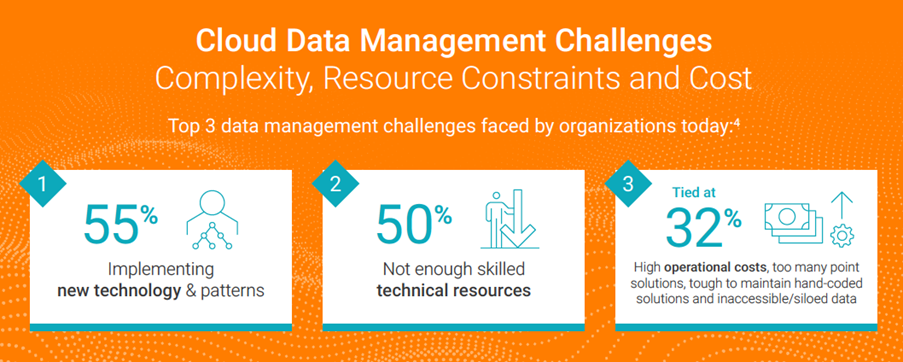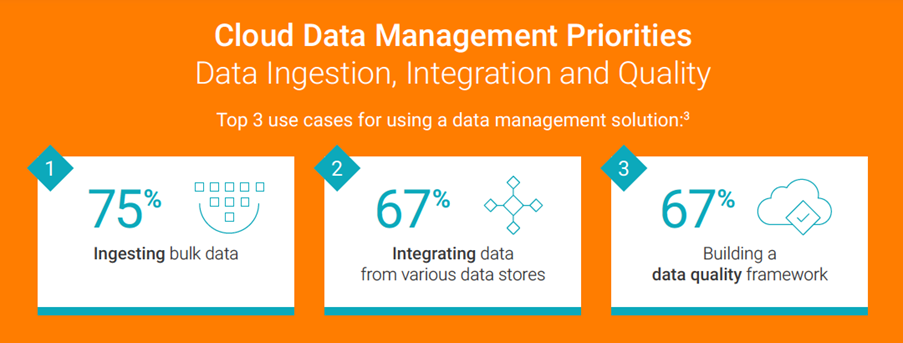Top 3 Cloud Data Management Challenges and Priorities in 2022
Why Cloud Data Management Matters

As the modern enterprise becomes more cloud-centric and new sets of data users (business analysts, data scientists, etc.) emerge, having the right tools and processes to manage all that data is critical.
Having the proper cloud data management strategy and solutions in place can help you realize several competitive advantages, including:
- Enhanced analytics through improved integration and ingestion
- Improved data security and data governance posture
- Stronger data quality to avoid the “garbage in, garbage out” problem
- Rapid data discovery and enhanced metadata management
- Optimized record maintenance and management across systems
Informatica recently conducted a survey with data leaders across several industries. Below are our findings on current data management challenges and priorities.
Top 3 Data Management Challenges
Implementing cloud data management platforms, tools, policies and procedures to gain control of your organization’s data is not easy. Let’s take a look at the key hurdles businesses like yours are currently facing:

#1. Complexity
55% of data leaders struggle to implement new technology and patterns
Complexity seeps into every aspect of cloud data management — from complex data landscapes to complicated pricing and hidden cloud fees. As cloud adoption accelerates, data and IT leaders can find it difficult to connect cloud and multi-cloud with on-premises environments. Disparate tools don’t work well together. And moving projects from development into production often takes too long because of system integration, data quality and DataOps issues.
#2. Resource Constraints
50% of data leaders believe they don’t have enough skilled technical resources for cloud data management
CIOs and CDOs are challenged to find enough resources to do all the work that data-hungry organizations demand. Often, this work requires highly skilled and specialized resources. While IT struggles to meet demand, the business wants to move to the cloud even faster. Lack of resources and self-service capabilities make IT a bottleneck.
#3. Cost Overruns
32% of data leaders associate cloud data management with high operational costs
Moving large amounts of data in and out of clouds is expensive. CIOs and other IT leaders find it difficult to predict cloud costs, let alone manage them. They often lack visibility into costs and aren’t able to see who is using what cloud services and to what degree. Moving data into and out of cloud data warehouses and lakes incurs significant data transfer charges. Too often, organizations simply throw people and compute hours at these data processing problems instead of finding a more cost-effective solution.
Top 3 Cloud Data Management Priorities
Business requirements and processes are always changing in today’s competitive landscape. Let’s review the top data management priorities organizations are focused on today:

#1. Data Ingestion
75% of data leaders prioritize ingesting bulk data from disparate sources into the cloud
Data ingestion is the process of moving and replicating data from various sources – databases, files, streaming, change data capture (CDC), applications, IoT, machine logs, etc. – into a landing or raw zone like a cloud data lake or cloud data warehouse where it can be used for business intelligence and downstream transactions for advanced analytics readiness. As organizations embark on their cloud modernization journey, they face challenges around legacy data and an increase in disparate data sources and data volume, velocity and integration silos. This makes data ingestion one of the biggest roadblocks.
#2. Data Integration
67% of data leaders believe prioritizing integrating data from various sources is a key priority
Once the data is ingested into a landing or raw zone, you need to parse, filter and transform the data to make it available for advanced analytics and AI usage. This is where data integration comes in. It helps to transfer and sync different data types and formats between systems and applications. Data integration is not a one-and-done event, but a continuous process that keeps evolving as business requirements, technologies and frameworks change. Organizations may find data integration challenging as data formats and sources are increasing over time. Other integration concerns include rising volumes of low-quality data, outdated data and siloed data.
#3. Data Quality
67% of data leaders believe that building a data quality framework is crucial
Data quality ensures that your organization’s data is fit for purpose. It refers to the overall utility of a dataset and its ability to be easily processed and analyzed for other uses. Managing data quality dimensions such as completeness, conformity, consistency, accuracy and integrity, helps your analytics and AI/ML initiatives deliver trustworthy results. Data quality issues are often the result of database merges or systems/cloud integration processes in which data fields that should be compatible are not due to schema or format inconsistencies. When data is of excellent quality, it can be easily processed and analyzed, leading to insights that help organizations make better decisions.
Learn More Now
Data management and integration are top of mind for forward-thinking organizations. To learn more about other concerns data leaders like you have today, take a look at the infographic now.








